Leg pain in runners or Shin splints or medial tibial stress syndrome.
Medial tibial stress syndrome or shin splint is a painful condition where pain along the shin or more specifically along the posteromedial border of the shin occurs following running, jumping or other sports. It is common in athletes specially runners. It is caused by repetitive stress loading of the shin bone (tibia) due to running or jumping. Changing the mileage or the distance of running or changing the surface on which the athlete run is a common preceding event to shin splint.
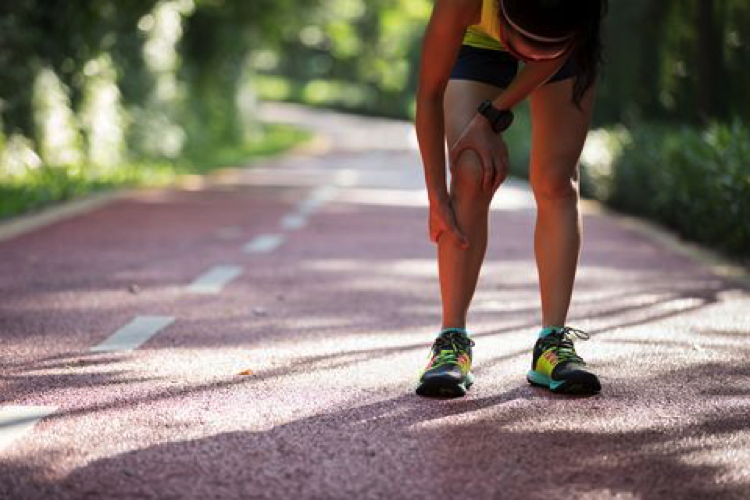
Symptoms and signs: After running or repetitive jumping pain occurs along the shin. Usually it occurs along the middle or distal third of front or inner side of the leg. Pain might be too severe to continue running. You can often feel a sore area of around 5-7cms along the inner edge of the shin by pressing around the area. Pain usually starts during a run and can last throughout the run and afterwards. Mostly one leg which is dominant one (right leg in in right handed) is involved first.
What causes shin splints in runners?
Shin splint is an overuse injury. Some provocative factors are known to make runners prone to shin splint. Common factors are flat feet, rigid arches, stiff calf muscles, bow legs and knock knees, pronated feet, ankle instability, inadequate stretching, worn shoes etc. In beginners hard training may cause tight calf muscles and reduced ankle dorsiflexion (upward movement of foot)and increase tendency for excessive pronation leading to increased internal tibial rotation and shin splint.
Sudden change in the volume of running like increasing mileage or duration or running in experienced runners may cause shin splint. In beginners running too much and too fast often lead to shin pain.
How to treat shin splints???
Rest for 1-2 weeks, icing of inflamed shin (20 min every two hours) and compression stockings help in reducing inflammation and pain. Stretching exercises of calf muscles, and Achilles tendon and strengthening of hip abductors are mainstays of treatment in most of the new players. Increasing core strength is also important in preventing recurrence. Pain killers (NSAIDS) and steroids may help relieve pain. Efficacy has not been proven of oral or local steroids for treatment of shin splints. After initial period of rest walking is started in air cast for 2 weeks. Then jogging is resumed in air cast for 4 to 6 weeks. If pain recurs then walking /jogging in air cast is extended up to 8 weeks. Running is then gradually assumed.
Orthotics: use of medial arch support help in correcting over pronation of the foot while walking and running. Use arch support in a good quality sports shoe.
Exercises for shin splint:
- Toe curl exercises: Stand on a towel and with the toes gather it and pull it toward you. Repeat it 15 times and then do with other foot.

- Toe stretch: Sit as shown in the picture on your toes. Maintain this position for 30-45 seconds.

- Heel stretch:
Stand on a step unsteadily with your toes of the right foot on the edge of a step. You can hold railing for support. Now shift your weight on the right foot, bend your left knee and lower down the right heel below the edge of the step. You will feel a stretch at the back of the right leg. Now come to start position again and repeat this exercise for 20 times.

- Shin stretch
Sit on your heels as shown in the picture. Keep your heels and ankles touching together and try not to sit in between your heels. Keep this position for 15-20 seconds and then relax. Repeat it for 15 times. You can also stretch your shin while sitting on a chair or stool as shown in the picture.
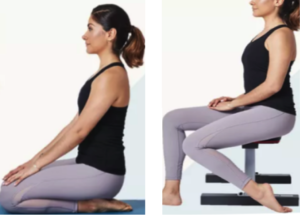
- Standing shin stretch
You can also stretch you shin in standing position. Point your toes towards ceiling and then lower the foot down as shown in the picture. You will feel a stretch in your foot and front of the leg. Repeat this exercise for 20 times.
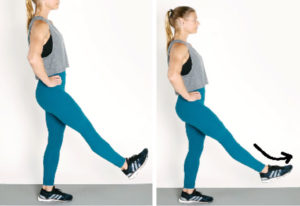
- Increase your hip abductor strength: Many studies have shown that runners who suffer with shin splint have weak hip abductors. This affects their landing and push off while running and jumping. Increasing hip abductor strength is very important to prevent shin splint pain.
Exercises to improve hip abduction strength are given below:
Single leg lunge: Do single leg lunges as shown in the pictures. Raise your hip, hold for a few seconds and then relax. Do 15-20 repetitions.

Abductor stretching: In side lying position, keep your pelvis perpendicular to the floor, don’t lean backwards and now open up your knees as shown in the picture below. Open as much as you can and come back to start position and do 15-20 repetitions.
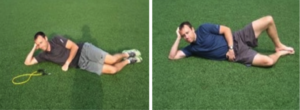
Abductor strengthening: In side lying position wrap a thera band around your legs and then raise your leg against resistance of thera band. Hold the raised leg for a few seconds and then bring it down back. Do 15-20 repetitions.
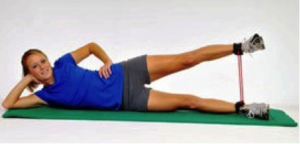
- Improve your core strength: Do forearm planks. Keep your feet hip width apart and elbows in line of shoulder. Hold this position for 45 seconds and repeat it for 2 more times.
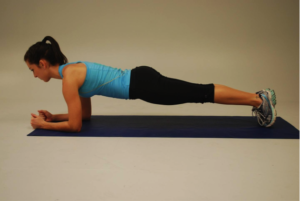
- Walk on your toes for 30 to 60 seconds and repeat for 15 times.
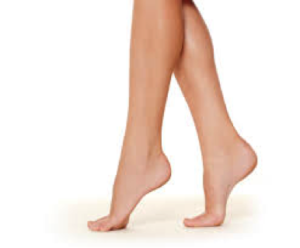
- Heel raise: stand and raise your heels. Maintain it for 15 seconds and then relax. Do 15 repetitions.
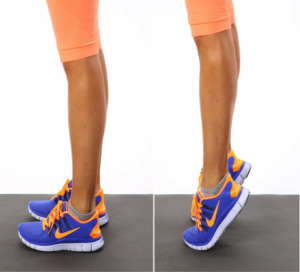
ABOUT THE AUTHOR

TESTIMONIAL

मेरा दाए पैर में चोट लगने के कारण टेढ़ा हो गया था जिसकी वजह से मुझे चलने में भी परेशानी हो रही थी. डॉ जितेश ने ऑपरेशन कर के इसे सीधा किया. में बिलकुल ठीक हूँ .

मेरी बेटी के घुटने में इन्फेक्शन होने के कारण वो दर्द की वजह से सो भी नहीं पाती थी. डॉ जितेश ने ऑपरेशन कर के इसे ठीक किया. बहुत धन्यवाद।

I remember that Dr. Jain came out from his clinic to see my mother because my mother was not able walk a single step. He did total knee replacement on both side and now my mother is walking without aid.
OPENING HOURS
| Monday – Friday | 17:00 – 20:00 |
| Sunday | OFF |
